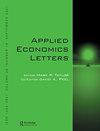数据资产能刺激企业研发投资吗?
IF 1.3
4区 经济学
Q3 ECONOMICS
引用次数: 0
摘要
摘要本文以2007 - 2019年中国a股上市公司为样本,研究数据资产对企业创新的影响。研究发现,数据资产显著增加了企业的研发支出。此外,对于信息更复杂或面临更大竞争压力的企业,这种积极影响更强。这种证据模式表明,数据资产可以提高企业整合有价值信息的能力,从而提高企业的竞争力,从而导致更密集的创新投入。进一步的分析表明,数据资产的使用还改善了专利申请和授予方面的创新产出,特别是高质量创新。关键词:数据资产、研发支出、企业创新、竞争压力、信息集成jel分类:G30O31O32致谢所有作者贡献均等。披露声明作者未报告潜在的利益冲突。注1德勤指出,数据已成为一项关键的战略资产。数据不仅仅是公司历史经营业绩的记录,还应该作为业务运营的一个核心方面进行系统的管理和利用关于数据资产的可变结构的详细信息见附录A.3。数据资产的另一种度量的结果,在企业首次在MD&A中提到数据资产之后的时期等于1,否则等于零采用Heckman治疗效果模型时,结果成立。基金资助:国家自然科学基金项目[72202035,72302048];对外经济贸易大学国际商学院创新工程实验室[102/78220301];中央高校基本科研业务费专项经费[CXTD13-03]。本文章由计算机程序翻译,如有差异,请以英文原文为准。
Can data assets spur corporate R&D investment?
ABSTRACTThis article investigates the impact of data assets on corporate innovation using a sample of Chinese A-share listed firms from 2007 to 2019. We find that data assets significantly increase firms’ research and development (R&D) expenditure. Moreover, this positive impact is stronger for firms with more complex information or facing greater competitive pressures. This pattern of evidence suggests that the data assets can improve firms’ abilities to integrate valuable information and increase their competitiveness, leading to more intensive innovation inputs. Further analysis shows the use of data assets also improves innovation outputs regarding patent applications and grants, especially high-quality innovations.KEYWORDS: Data assetsR&D expenditurecorporate innovationcompetitive pressuresinformation integrationJEL CLASSIFICATION: G30O31O32 AcknowledgementsAll the authors contribute equally.Disclosure statementNo potential conflict of interest was reported by the author(s).Notes1 Deloitte points out that data has become a critical strategic asset. Data is not merely a record of firms’ historical operating performance, but should be managed and leveraged systematically as a core facet of business operations.2 Detailed information on the variable construction of data assets is provided in Appendix A.3 Results hold for another measure of data assets, which equals one for the period after firms first mentioned data assets in the MD&A and equals zero otherwise.4 Results hold when using the Heckman treatment effect model.Additional informationFundingThis work was supported by the National Natural Science Foundation of China [72202035, 72302048]; the Innovation Engineering Laboratory of the International Business School of the University of International Business and Economics [102/78220301]; “the Fundamental Research Funds for the Central Universities” in UIBE [CXTD13-03].
求助全文
通过发布文献求助,成功后即可免费获取论文全文。
去求助
来源期刊

Applied Economics Letters
ECONOMICS-
CiteScore
2.90
自引率
6.20%
发文量
460
期刊介绍:
Applied Economics Letters is a companion journal to Applied Economics and Applied Financial Economics. It publishes short accounts of new original research and encourages discussion of papers previously published in its two companion journals. Letters are reviewed by the Editor, a member of the Editorial Board or another suitable authority. They are generally applied in nature, but may include discussion of method and theoretical formulation. In a change to the format of the Applied Financial Series of journals, from 2009 Applied Financial Economics Letters will be incorporated into its sister journal Applied Economics Letters.
 求助内容:
求助内容: 应助结果提醒方式:
应助结果提醒方式:


